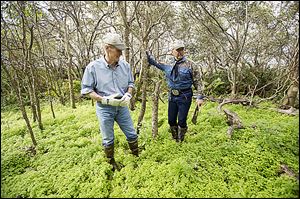
Pythons a needle in Everglades’ haystack
3/3/2013
U.S. Sen. Bill Nelson (D., Fla.), left, and Florida wildlife commissioner Ron Bergeron, search the grassy underbrush for pythons on an island in the Everglades.
FLORIDA CITY, Fla. — What took place in the swamps and watery grasslands near here recently could best be described as a desperation move, wrapped up in a publicity stunt, and disguised as an old-fashioned wild west roundup. It wrought a few interesting photos and a measure of scientific data, but little of the targeted star of the show.
It had a snappy name: “The 2013 Python Challenge” — but what it turned out to be was a very hard lesson in our inability to turn back the clock on certain ecological disasters.
The issue is this — exotic snakes from the other side of the globe are a destructive force in the fragile ecosystem of the Everglades, that wide expanse of freshwater marshes that once occupied about 4,000 square miles in south Florida, but is now less than half that size.
Invasive snakes, primarily pythons, reached the Everglades either through accidental release from captivity during hurricanes, or the intentional release when they were discarded by irresponsible pet owners who found the pythons had grown too large to manage. One day you are feeding them mice, and a few months later they want to eat your poodle.
Once in the endless labyrinth of grass and water, the pythons multiplied rapidly and started to devour the native fauna. Wildlife biologists estimate there could be upward of 100,000 pythons now roaming the region.
Scientists and researchers from several universities and the U.S. Geological Survey looked at the impact of the pythons on other animal populations in a 2012 study, and found that rabbits and foxes had been wiped out, while the number of bobcats, opossums, and raccoons in the Everglades had been reduced by nearly 99 percent.
Given the elusiveness of the snakes, their natural camouflage, the vast expanse of the Everglades area, and the python’s ability to procreate, nothing the wildlife biologists tried had much effect. On a visit here about a year ago, it was evident that this losing battle had left them frustrated by the hopelessness of the situation.
The month-long Python Challenge was a creative vehicle the Florida Fish and Wildlife Conservation Commission wanted to use to harvest as many of the snakes as possible, while also increasing public awareness about pythons and the threat these invasive species present to the Everglades and its wildlife. Responsible pet ownership was also part of the message, and organizers anticipated learning more about their powerful foe through this project.
The intense promotion of the event worked, as close to 1,600 people from 38 states and Canada paid the $25 registration fee and set out to hunt for pythons in the huge network of more than a million acres of interconnected wildlife management areas outside the boundaries of Everglades National Park proper. Hunting is banned inside the park, except for those with special python removal permits.
But after all of the publicity and photo-ops and attention, just 68 pythons were harvested, with cash prizes for the hunter taking the largest python, and the hunter harvesting the most of the invasive reptiles. The hunters found the terrain to be extremely difficult to traverse, and the snakes, which are equally comfortable in the water or in the trees, nearly impossible to locate.
Nick Wiley, executive director of the Florida Wildlife Commission, looked for a ray of sunshine in what appeared to be an otherwise gloomy final count.
"Every python taken out of the system is a great benefit,” Wiley said. “And we know that it takes a significant investment of time to capture one python. As it does for any kind of hunting, it's not always easy."
Florida Sen. Bill Nelson took part in the hunt, but his day in the Everglades yielded no snakes, only a large press entourage.
“These pythons eat everything in the Everglades: bobcats, deer, even alligator and maybe endangered Florida panther.” Nelson said.
Researchers from the University of Florida will perform necropsies on many of the pythons that were harvested during the event, in an effort to better understand these creatures that can grow 20 feet long and have been seen consuming whole deer and alligators in the Everglades.
"It's an unprecedented sample, and we're going to get a lot of information out of that," said Frank Mazzotti, wildlife professor at Florida.
Wildlife biologists will also use several of the live-caught pythons to hopefully lead them to others lurking in the sea of grass. Three males were outfitted with radio transmitter collars and released, and during breeding season the scientists hope these pythons will lead them to breeding females.
Another option being considered is the use of dogs. Auburn University researchers have had success testing the ability of Labrador retrievers to track the snakes by their scent, but such a program is labor intensive and expensive, since human handlers are involved, and the funding to put an operation in place has not been allocated.
Wiley said he was grateful for the Python Challenge’s exposure and added the effort “gives hope that we can make progress on this difficult conservation challenge by working together.”
The event and its surrounding hoopla have ended. The real challenge of what to do about the pythons remains. This genie was carelessly let out of the bottle, and in the Everglades, it has far too many places to hide.
Contact Blade outdoors editor Matt Markey at: mmarkey@theblade.com or 419-724-6068.